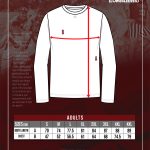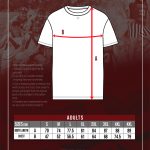We have various garment types in our range with each undergoing a different manufacturing process, plus additions like protective coatings. Each product we manufacture uses different techniques once design has been signed off. Learn how it’s made by reading through our sections below.
Thread, Fabric and Textiles
First it all starts with the textiles. For shirts, shorts, hoodies and so on, we use a range of materials including cotton, polyester and blends. Cut from rolls, our factories then use templates to cut and sew together the various pieces.
For beanies, we use a specialised method with digital artwork that easily translates into the knitting machinery for detailed patterns, colours, and lettering.
Our hats come in many forms including towel hats, trucker caps, and the classic baseball cap. We use high-quality textiles to cut, form, and reinforce our hats during manufacturing to ensure its shape and fit are 100% on point.
We keep track of each textile we use and their various properties like material construction, thread count, thickness, additional coatings, stretch, softness, weight, and heat insulation.
Graphics: Sublimation, Screen printing, and Embroidery
After selecting the right textiles for the job, then dye sublimation printing them – a process that ensures vivid colours and long-lasting graphics. Exactly what you want for tough and durable garments like football singlets and shirts. The ‘sharpness’ or ‘clarity’ of your graphics and logo with sublimation are dependent on the thread count of the textile. More threads, means higher quality.
For caps, beanies, hats, and some shirts, our embroidery designs are the best method for displaying logos and enhancing their details. This manufacturing method involves digital designs being fed into the embroidery machine which stitches many threads to create the design.
Screen printing is the most traditional method to apply images or text to garments. Using multiple stencils and a combination of inks, screen printing creates bold colours and fine details on various fabric types.
Protective Coatings
For some textiles, additional coatings are added to protect against UV, stains or water instead of using thicker materials. After all, you don’t want to be wearing your finest flanny in the summertime.
Should I Be Concerned with How It’s Made?
We’re absolutely happy to answer any questions you have on how our garments are made, but no, you shouldn’t be too concerned. All of our garments are made to the highest standard and go through rigorous quality control processes. . That’s why we’re here, the experts in custom clothing and headwear.
During the consultation process, we endeavour to understand what your vision and wants are for your custom apparel. We’ll then match a process to suit your needs. No fuss, no hassle.
The fabric used for a fishing shirt would not be suitable for footy shirts or even school uniforms. It’s our job to know what should be used where and it’s this knowledge that makes us a market leader in the custom apparel space. We’ve delivered thousands and thousands of garments to our clients over the years, reinforcing our high-quality service and exceptional end products.
So there you have it! Every product has a lot of time, effort, and research invested into it to ensure that it is up to snuff and ready to show you in your best light.
Got Questions?
We understand what materials to use in various applications based on our experience with a variety of industries and lifestyles. Check out our FAQ page and do not hesitate to contact us if you have any queries, and we’ll be delighted to assist.
Anything Else?
We do a LOT, so like Macca’s we have a hidden menu of sorts, and we’re always on the hunt for new ideas. If you haven’t seen it advertised, or you have but can’t find it, don’t be alarmed!
There’s no such thing as a silly question so flick us an email and we’ll let you know if we can do it. We know we’d be nothing without our amazing customers so we’ll always be striving to meet your needs.
Contact Us

